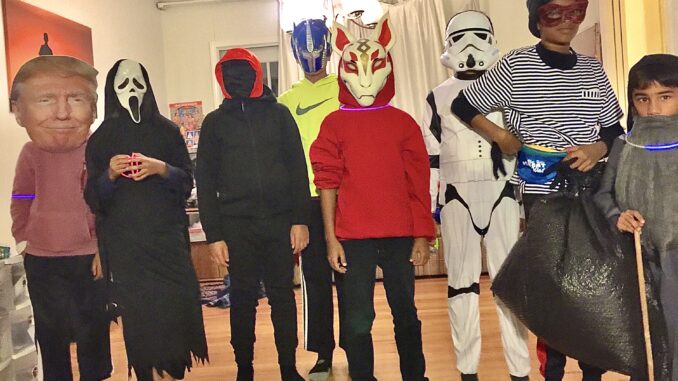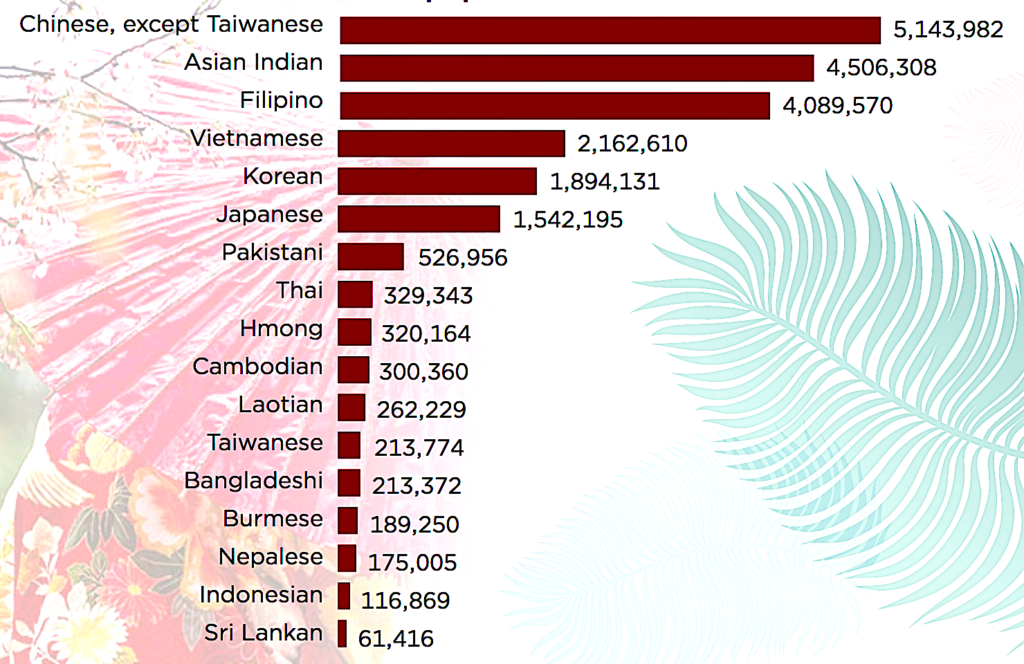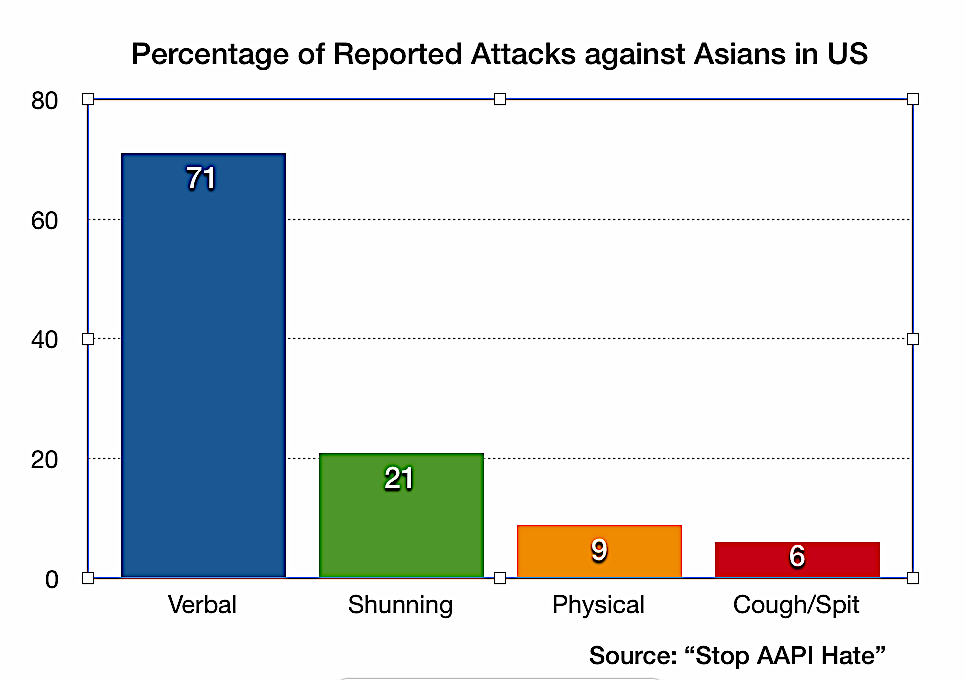
Since the pandemic began in December 2019, there has been a marked animosity against Asians around the world.
In the US, the media and social media have highlighted increased attacks against Asians, especially those of Chinese descent. Victims have been shunned, shoved, spat on, cursed, coughed on, punched, bullied, and also blamed for COVID-19.
So on March 2020, a coalition of Asians formed “Stop AAPI Hate” to track and respond “to incidents of hate, violence, harassment, discrimination, shunning, and child bullying against Asian Americans and Pacific Islanders” in the US.
There are a total of 22.6 million Asian Americans, dominated by the Chinese (except Taiwanese) at 5.1m, Indians at 4.5m, and Filipinos at 4m. California has the highest Asian population at 16%, next NY has 9%, then Texas at 5%. (see table)

Stop AAPI Hate reported almost 3,000 cases around the US, which occurred mostly in California (43.8%) and New York (13.0%). The actual number of anti-Asian attacks are likely higher since many are unreported.
Incidents occur mostly in business establishments (38%), in public places, ride-shares, and at work—all while the victims passively go about their daily life—as they walk, stand on the street, ride vehicles, wait in line, enter a store or restaurant, or even near their home.
In San Francisco, California, a 69 YO Asian woman was mugged in front of her doorstep. It’s unclear if this was a mere robbery or a racial attack.
It’s a hate crime if the victim was targeted because she belongs to a particular social group, which can be based on certain traits like age, gender, race, religion, appearance, and the like. You must prove that the crime was motivated by prejudice.
Asian Americans even get harassed at home. A Southern California family endured continued harassment from teenagers, which prompted kindly neighbors to form a watch on their lawn to deter future attacks.
Last February seemed to show a spike in anti-Asian hate crimes. In Los Angeles, California, a 27 YO Korean American man was waiting on a street in Koreatown when two men charged at him with racial slurs then beat him up. They only stopped when another Asian man approached them.
In New York, crimes against Asian Americans in 2020 jumped from 3 to 28, a low number, yet news and social media fuel the fear that Asians are now widely targeted. Asian business owners report robberies and Asian communities have become fearful. Still, most crimes reported by Asian victims are not classified by the NYPD as hate crimes since the suspect’s bias was not proven.

So is there a spike in anti-Asian sentiment due to COVID-19 or are we just more aware of it now?
“How long has this been going on?”
A long time, says Adrian De Leon, assistant professor of American studies and ethnicity at the University of Southern California in his article “The long history of racism against Asian Americans in the U.S.” https://www.pbs.org/newshour/nation/the-long-history-of-racism-against-asian-americans-in-the-u-s
The 1848 California Gold Rush saw a wave of immigrants workers, many from Italy, Germany, Mexico, and China. The latter two provided cheap labor which antagonized and threatened the European workers. Faced with racism, Mexicans and the Chinese endured harsher work conditions for lower pay than other workers. To discourage immigrants, California imposed the 1850 Foreign Miners’ Tax, which should affect all migrants but was only strongly enforced against Mexicans and Chinese miners.
For the next 20 years, California enacted multiple laws to penalize, exclude, and burden Asians, like the 1879 declaration that the Chinese were an “undesirable” race; Mongolians were banned from schools; and the 1880 prohibition on mixed race relations. Laws became targeted specifically to Chinese, like the ban on carrying “baskets or bags attached to poles carried upon back or shoulders on public sidewalks”; the Chinese could not testify in court for or against a white person; they were hindered from fishing; and were taxed more and required more documents than other residents. Even shipowners were fined or taxed for Chinese passengers.
Since the 19th century, negative public sentiment against the Chinese in San Francisco grew out of propaganda that they were unclean and therefore unfit for American citizenship. This led to the passage of the Chinese Exclusion Act of 1882 which banned the entry of Chinese laborers into the US for 10 years. This was extended in 1892, then made permanent in 1904. (De Leon)
In 1906, the Immigration and Naturalization law only allowed a “free white person” and those of African descent to become naturalized US citizens.
In 1922, the Supreme Court clarified that “free white person” only refers to Caucasians and excludes “the brown or yellow races of Asia”, and thus denied the naturalization of Japanese-born Takao Ozawa, who had lived in the US for 20 years, wherein he and his children were educated.
“The Immigration Act of 1924 codified Asian exclusion,” wrote Lon Kurashige in his book “Two Faces of Exclusion—The Untold History of Anti-Asian Racism in the United States” (2016). He is an Associate Professor of History and American Studies and Ethnicity in the University of Southern California.
From 1898 to 1946, the US justified its 48-year colonization of the Philippines for the latter’s “political and medical unruliness” and US officials “identified two enemies: Filipino insurgents against American rule, and “tropical diseases” festering in native bodies.” (De Leon). On the positive, as a US colony, many Filipinos were naturalized or became US residents.
After Japan bombed Pearl Harbor in 1941, US President Franklin Roosevelt ordered the removal of resident enemy aliens from alleged military areas in the West.
“On the West Coast, long-standing racism against Japanese Americans, motivated in part by jealousy over their commercial success, erupted after Pearl Harbor into furious demands to remove them en masse to relocation camps for the duration of the war.”
While it affected some Italians and German Americans, it largely targeted “Japanese immigrants and their descendants, regardless of American citizenship status or length of residence, were systematically rounded up and placed in detention centers….Many lost businesses, farms and loved ones as a result.” (history.com)
In 1943, when China became a US ally during World War II, the ban on Chinese migration was finally lifted—61 years later.
However, history is incomplete. So it’s unfair to conclude that discrimination against Asians was a national US consensus. Kurashige found that many influential Americans voiced their opposition to racism, but such proponents were not recorded.
Media makes us aware of racism
History has shown that numerous socio-economic factors contribute to racism. It’s not just this pandemic or previous epidemics like SARS that heightened anti-Asian sentiment in America.
As long as people from different backgrounds mingle with each other, there will always be prejudices against each other. Our brains are geared to jump to quick decisions and opinions. But that doesn’t mean we should act wrongfully.
Good thing social media instantly reveals unfairness and injustice. CCTV captures attacks, crimes, and incidents as soon as they happen, then journalists can immediately report them. Anyone with a camera can post bad behavior and call out racism, prejudice, and abuse. That’s likely why we have an increased awareness of anti-Asian attacks.
When we raise public consciousness about an issue, officials can act on it and influencers can decry it. This can embolden others to call out bad behaviors and help the victims. Attackers may hesitate to show hate at the risk of a public backlash.
When the public becomes aware of a problem, it changes the public mindset, which can lead to changes in policies and behaviors. That’s what happened to #ClimateChange, #MeToo, and #BlackLivesMatter.
Such vigilance can slowly raise our expectations of what is acceptable behavior. We begin to re-educate ourselves and others, and teach children how to treat everyone with respect—regardless of how they look or seem.
Like love, we learn to hate. Prejudice begins early, as sang in one of my favorite musicals by Rodgers and Hammerstein, “South Pacific” (1949).
You’ve Got to be Taught
You’ve got to be taught to hate and fear
You’ve got to be taught from year to year
It’s got to be drummed in your dear little ear
You’ve got to be carefully taught
You’ve got to be carefully taught
You’ve got to be taught before it’s too late
Before you are six or seven or eight
To hate all the people your relatives hate
You’ve got to be carefully taught
Follow me on Instagram @IvyDigest and FB @IvyDigestbooks.
——————
